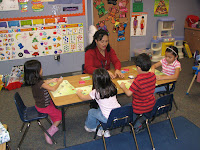And on that note, I ask you, how do you choose to live? What part of your journey will you cherish?
Small Group Instruction
Professional Resolution: Learn More About Guided Reading
Since my very first day in my very first classroom, I have been gung-ho about reading workshop. I have always been adamant about children choosing books they are interested in and dedicating large chunks of time to independent reading. I delivered the bulk of my instruction through whole group mini lessons and one-on-one conferences. Though I dabbled with book clubs, guided reading and strategy groups were foreign. Very simply put, I didn’t know about teaching this way so therefore, my students were never privy to the benefits of focused small group instruction.
My work as a staff developer has given me many occasions to reflect and think about my days as a classroom teacher. Looking back, I have come to recognize that without small group instruction, I was missing an important opportunity to guide my students to greater proficiency. Clearly, there was a gaping hole in my teaching repertoire which has sent me on a quest to right my wrong. It is my goal to learn everything I can about small group instruction, specifically guided reading.
Since embarking on this quest, I have attended workshops and read books on this topic. Recently I finished Guided Reading (amazon affiliate link) by Fountas and Pinnell and over the summer I read Teaching Reading in Small Groups
(amazon affiliate link) by Jenn Serravallo and Preventing Misguided Reading (amazon affiliate link)
by Jan Miller Burkins and Melody Croft. At this point, I feel like I have a sound theoretical knowledge of what small group instruction entails. What I need now is a better understanding of the practical implications of small group instruction. I am boggled and stymied by questions like how long should it take? If it goes on for thirty minutes, is that too long? When I pull up alongside students in guided reading groups to do a running record, is it okay if I don’t get to each student in the group? Do I need to take a running record of every student every time? If I don’t listen to a child read aloud and simply have a conversation about the text, is that okay? What is the best way to embed word study into a guided reading group? Proportionately speaking, how much time should the introduction to the text take?
The list goes on and on and that is why I have resolved to investigate these questions through my own independent study of this important teaching structure. I invite you to join me on my quest and encourage you to share your questions and answers to mine. I am very eager to hear stories from the trenches so that I can begin to piece together the guided reading puzzle. This blog will be the first in a series of forthcoming blogs that will reveal my learning process and thinking about this important teaching structure. I do hope that you join me and share your thinking. When it comes to guided reading, what would you like to learn more about?
The More We Know
Last night, I laid alongside my first grade son Nathan as he read a book aloud to me. As he read, I found myself listening intently. On the heels of finishing Preventing Misguided Reading, I wanted to understand his reading process better. The authors of this book, Jan Miller Burkins and Melody M. Croft, emphasized time and again the importance of helping children develop “smoothly operating systems” for reading and understanding text. As I listened to Nathan, I thought a lot about his mistakes. What were they telling me about what he knows about text? How did he solve problems that caused him difficulty? Was his system smooth and efficient?
To most people, Nathan is an exceptional first grade reader. However, as I listened to him, I realized that though skilled, he tends to over-rely on guessing words he doesn’t know. Rather than attending to what he knows about letters and sounds, he looks at the first letter and approximates what should go there. Up until now, this has worked well for him. But as I listened, I realized that as the texts he reads grow increasingly more difficult and are supported with fewer picture cues, this won’t be efficient. He is going to need to integrate other strategies into his repertoire to support him as he moves forward.
As I sat analyzing Nathan’s reading behavior, it occurred to me how the work of the reader in a guided reading group is similar to the work of a teacher of guided reading. When children gather to read a book that has been carefully selected by the teacher to present a reasonable challenge, children call upon all of the skills and strategies they know to be able to read that text. With the support of the teacher, children put all of their information together in an effort to nudge forward, to gain greater proficiencies in reading. All the while, the teacher is doing the same thing—calling upon everything she knows about how children learn to read to assess and understand the readers who sit before her. Whose system is efficient? Who is having decoding issues? What, specifically, characterizes those decoding issues? Who is understanding? Who is going deep? Who is fluent? Who understands character? Who understands theme? For whom is this book too easy? Who is ready to move groups?
I read Preventing Misguided Reading because I have so many questions about how to make small group instruction more effective. As I sit here reflecting on what I read and what I learned, I think that it comes down to this: Good guided reading instruction relies on what we know about HOW children develop “smoothly operating systems.” It’s not the materials and it’s not the methodology. Very simply, the more we know and understand about the complex process of learning to read, the more effective our guided reading instruction will become.


